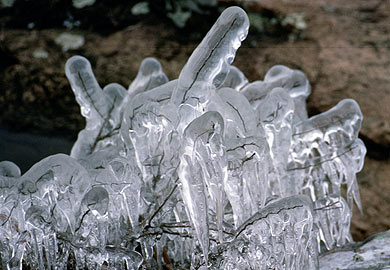DNR News
** Archived Article - please check for current information. **
April 7, 2014
Snow and ice may impact prescribed fire behavior
The wintry mix that fell on much of South Carolina may impact prescribed fires this season, according to the chair of the S.C. Prescribed Fire Council.
“The snow and ice appear to have compacted the fine fuels, such as grass and pine needles, that carry prescribed fires,” said Johnny Stowe, chairman of the S.C. Prescribed Fire Council and forester and wildlife biologist with the S.C. Department of Natural Resources (DNR). "Fire is complex in many ways, such as in the way it behaves, but in one sense it is simple–that is, it consists of three things–fuels, oxygen and a heat source. When fuels are compressed, less oxygen is immediately available in fuels, and this means that wildland fires tend to be less 'flashy.' But they may burn just as hot or hotter over longer periods of time, depending on the situation.
source. When fuels are compressed, less oxygen is immediately available in fuels, and this means that wildland fires tend to be less 'flashy.' But they may burn just as hot or hotter over longer periods of time, depending on the situation.
"This past summer’s heavy rains produced more fine fuels, which may lead to higher intensity fires," Stowe said. "It will be interesting to see what the combination of above-normal growth of these fuels from last summer’s rains and the recent snow and ice will result in for landowners conducting prescribed fires."
Landowners who wish to use prescribed fire to reduce fuels loads and improve forest and wildlife habitat should consult a registered forester, certified wildlife biologist or other experienced land manager at the earliest stages of the planning process, according to Stowe.
More News
- DNR offers guidelines for dealing with bears/report a sighting on the web
- Snow and ice may impact prescribed fire behavior
- Harry Hampton Wildlife Fund donates $134,525 to DNR
- Camp Wildwood of South Carolina open for 2014 registration
- DNR hosts series of youth fishing rodeos/family fishing clinics around the state
- Spring turkey season forecast fair
- Brushy ditch banks, weedy field borders are beneficial to wildlife around farms
- Boardwalk at Dungannon Plantation Heritage Preserve closed to protect nesting wood storks
- Boating Infrastructure Grant Workshop on April 22 in Charleston
- Lifetime Fishing License awarded for participation in Lower Saluda Trout Study
- Spring turkey hunters should order tags now for upcoming season
- Adult-youth fishing open at Bonneau Ferry
- Freshwater fishing trends
- Saltwater fishing trends
- S.C. weekly tidetable
- DNR video
- Archived news releases
